TEAC goes to Puerto Rico!
Students reflect on their trip to help a ravaged nation
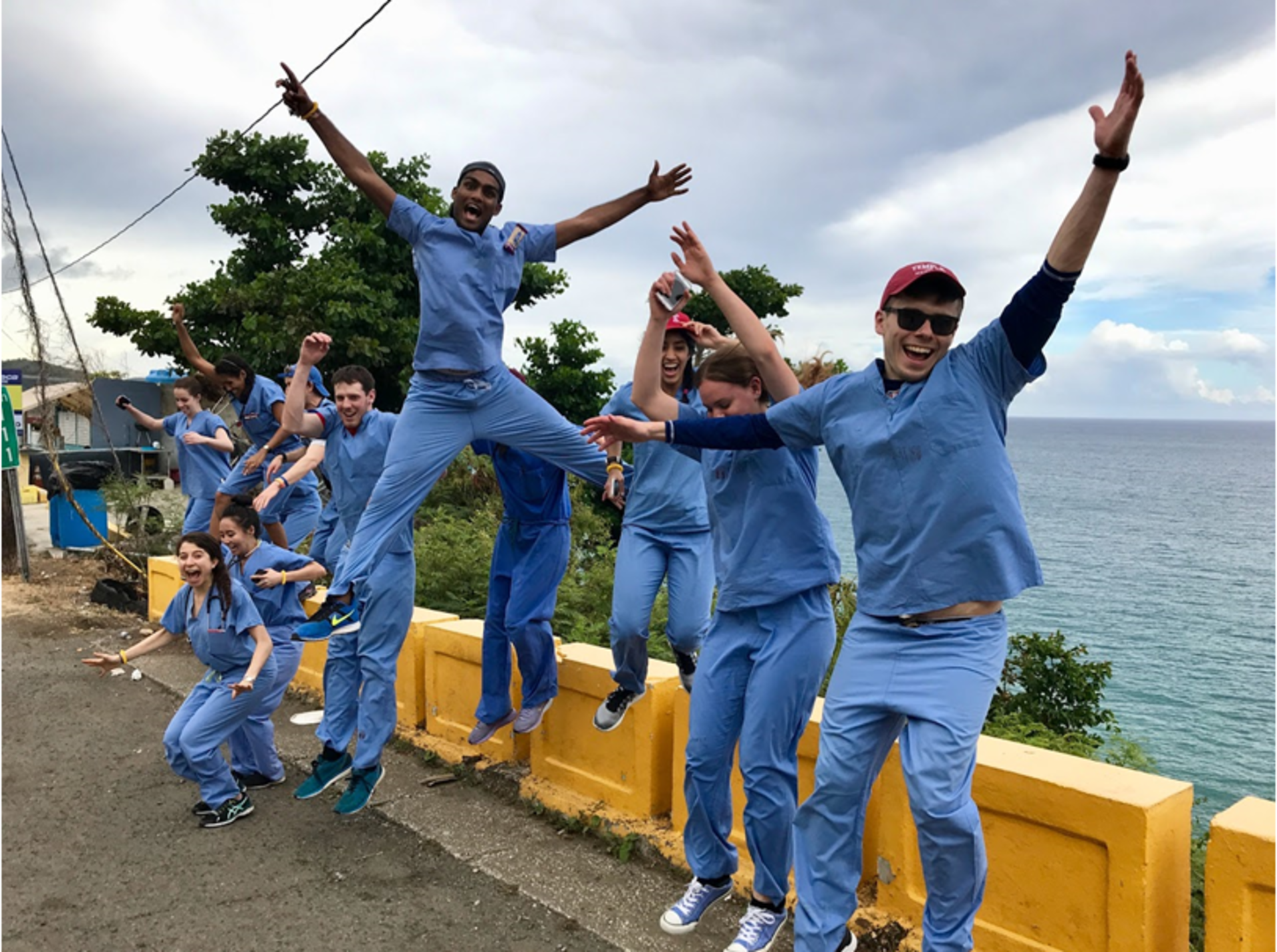
At the end of March, 15 medical students and four physicians traveled to hurricane-ravaged Puerto Rico to work in free medical clinics in some of the most hard-hit areas. They worked with 35 Puerto Rican volunteers. Physicians included three Temple faculty - Drs. Laura Martin, Kisha Martin and Natalia Ortiz - and Dr. William Greenfield, a 1969 graduate of Temple’s medical school. This was the 12th disaster-relief trip organized by the Temple Emergency Action Corps, TEAC, a student group, and funded by a foundation created by Dr. Greenfield. Here are reflections and photographs by six medical students.
• • •
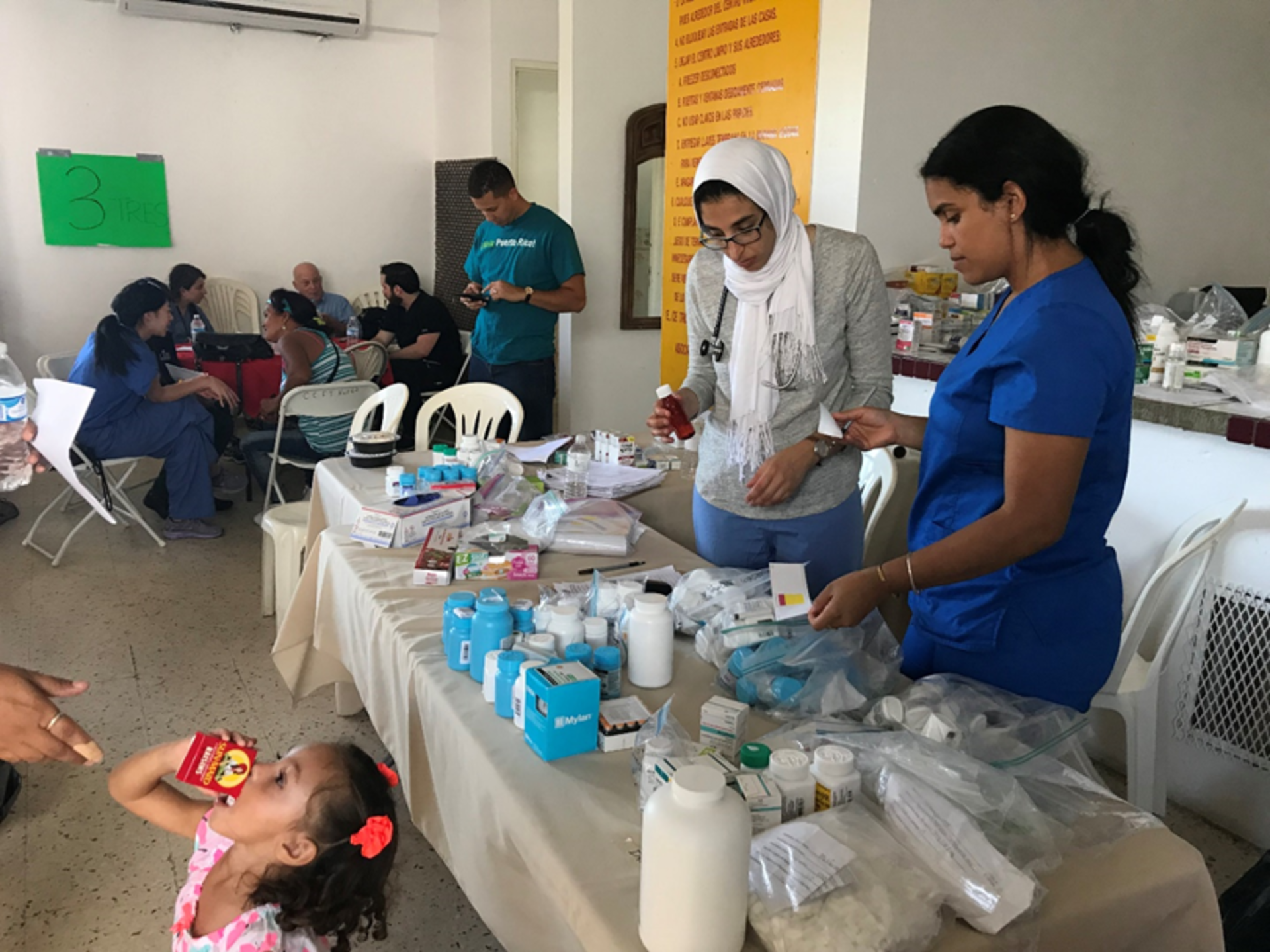
SELFLESS and GIVING
by Jani Swiatek, Lewis Katz School of Medicine, class of 2021
It was our first day off after working five hard days in the clinic and we were going to the beach. We followed the GPS and we should have been skeptical when it took us off the main road onto unpaved, narrow mountain roads that were barely wide enough for our SUV. After 30 intense minutes of trying to find our way out but going in circles and driving unknowingly to the actual edge of a cliff, we finally decided to ask for help. We spotted a man who had just parked near his house, so we quickly approached him. He began to tell us directions but then realized that we were very unfamiliar with the area. He insisted that he would lead us out, so he got into his car and within minutes we were back on the main road and on our way to start relaxing. Before we separated, we thanked him profusely, but it was impossible to express just how grateful we were. That moment was the first of many where I witnessed the kindness and selflessness of the Puerto Rican people.
The next was when we were going to see live music that same evening. We pulled into a parking area covered in sand. Something did not feel right, and I tried to put the car in reverse. We were stuck. Luckily, with some rocking and digging, we were able to get my car out, but our group’s other car, which pulled up near me to help me get out, was now stuck too. After what seemed like hours of bouncing, digging and pushing, it was clear that we were not going to be able to get ourselves out of this mess alone. Some locals who heard the noises of a car in trouble interrupted their own peaceful evening on the beach to help. With our car tied to theirs, they pulled us out within minutes. I think our expressions of relief showed our gratitude much better than anything we could muster in Spanish.
These two instances are among my favorite memories from our service trip to Puerto Rico because they gave us a glimpse of the character of the residents on that island. We all reflected that most people in the U.S. never would have gone out of their way like that to help stranded and confused foreigners. Too often we just walk quickly past with our heads down, trying not to make eye contact.
A spirit of willingness and selflessness seemed to be coursing through the veins of every Puerto Rican we met, including the community members who spent their entire week volunteering in our clinics. Their island had been devastated, but they were so selfless and giving to visitors they had only just met.
• • •
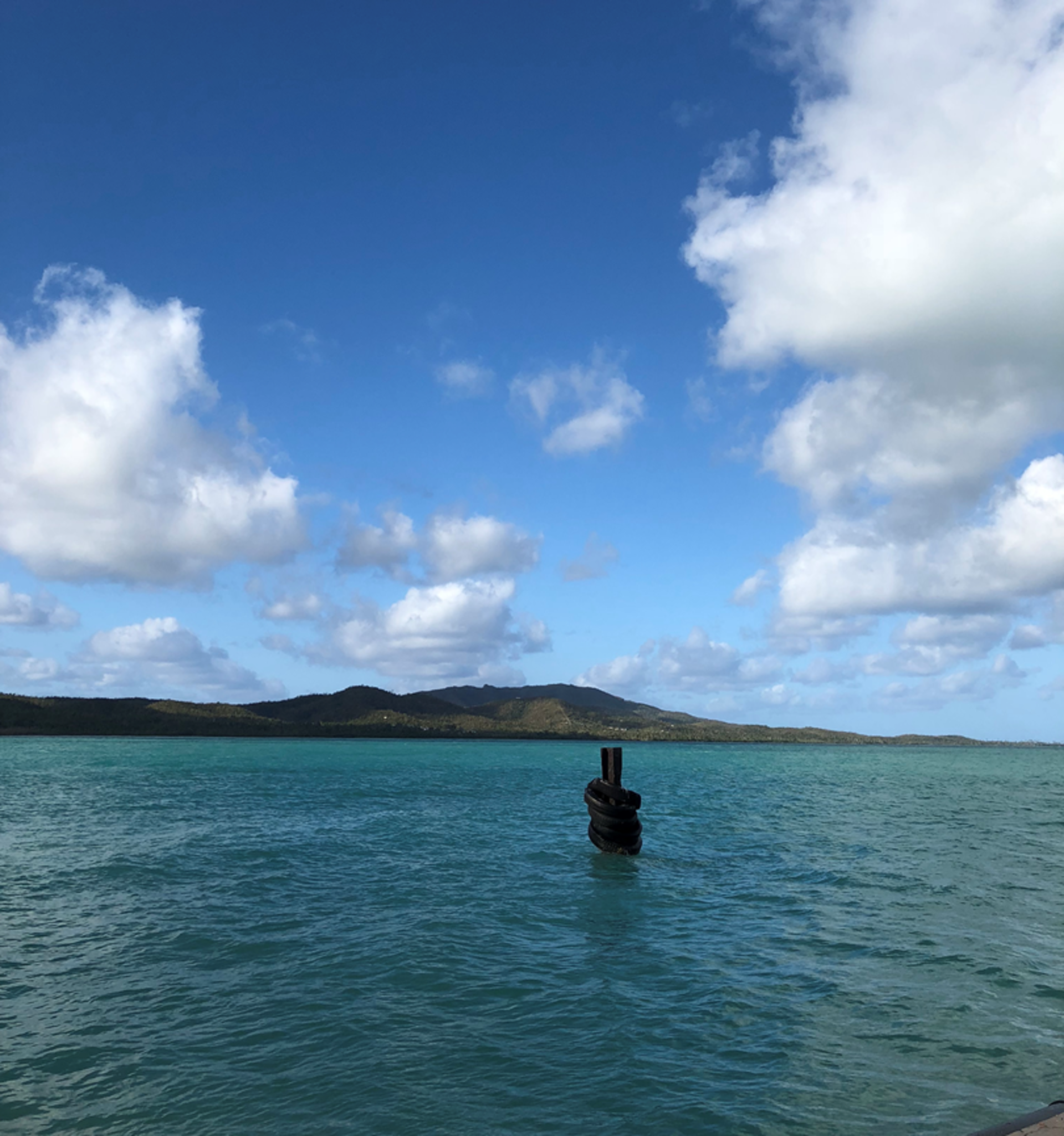
CHEMOSCAPES
by Simona Levsky, LKSOM class of 2021
The breath is knocked out of me by pink and blue cotton candy skies on a canvas. It was the first time I saw Lisa since I had found out that she was terminally ill with colon cancer. Growing up, I often joined the Gomez’ family for dinner and we would discuss her paintings over delicious meals I associate with the taste of home. I vividly remember a painting featuring a man and woman standing together in a vibrantly colored rainforest, the woman’s skin glowing and cheeks blushed, painted by a then healthier Lisa. Years later, as I looked into Lisa’s eyes I could see the person I knew my whole life, but in stark contrast all I saw were skin and bones surrounding her bulging clear blue eyes. I was stunned by the foreignness of her most recent painting, a chemoscape as she called it, which lacked the vivacity and humanity I once found comfort in.
Fast forward 8 months, and I found my breath knocked out of me in a different place. I had been working for the past three days on a team of medical students and physicians to provide medical relief to Puerto Ricans post hurricane Maria. That morning, I had woken up feeling frustrated with my lack of ability to speak Spanish and my inability to forge connections with the patients we worked with. I found it difficult to appreciate my meaning on the island and felt largely useless on our team.
After my morning run, I felt my emotions bubbling up inside of me and in effort to cool off I went down to the beach by our rental house. I threw my dirty sneakers and socks aside, looked up, and gasped for air as I realized I was staring at Lisa’s painting — I saw that same pink and blue cotton candy sky here in Guayama, Puerto Rico. Ahead of me was a vast and infinite space that I felt filled with Lisa’s presence. I knew that the view I saw had once invigorated Lisa, inspiring the strength, kindness and generosity she gave back to humanity throughout her meaningful life and art. I allowed nature to fill me with hope that I could change people’s lives.
This moment permeated my interactions with patients thereafter. “Nature’s beauty has its costs” — a Puerto Rican medical student translated a patient’s words. At first it was difficult to reconcile the exquisite beach views of our rental house with the blue-tarped roofs of ruined houses, fallen electric poles concealing views of farmland and grassy hills, and drooping palm trees lining the pothole-filled roads after destruction by Maria. My perspective gradually transformed as I gained intimate knowledge from hearing the stories of the victims of the hurricane. During an interaction with a patient and one of our psychiatrists, a patient spoke about her difficulties since having her home destroyed. As her tale spiraled deeper into negativity, the physician abruptly veered the conversation in a different direction by asking her whether she gardened in her free time. The patient’s demeanor changed markedly; although her garden was destroyed by Maria, she mentioned that a few weeks ago some of the flowers in her new garden began to bloom again. The patient’s eyes filled with hope for the first time during the long conversation, beaming with strength. Though we continued to discuss her difficulties, she took a lighter approach to describing the emotions that she felt and began to slip in statements of positivity. Nature, which had taken everything that she had known and loved away from her so suddenly, seemed to be aiding her on her path to recovery. This patient made me think of Lisa. I imagine that in her last months of life, Lisa came to terms with teetering between life and death by latching onto nature, as she expressed through her paintings.
As I reconciled the cruelty of nature with its centrality to the lives of the people we encountered in Puerto Rico, I gained a better understanding of how best I could contribute to the relief effort. As the days went on, I saw that the resilience of this population overcame its distress. I saw that same fight and resilience in Lisa throughout her battle. This understanding led me to embrace my role in establishing hope and strength, which became one of our team’s most important contributions. Not only did I take vitals, distribute medications, and provide vaccinations, but I also used body language and gesturing to forge connections; with a little bit of help from Spanish translators, I was able to put smiles on many patient faces. I know Lisa would be proud.
• • •
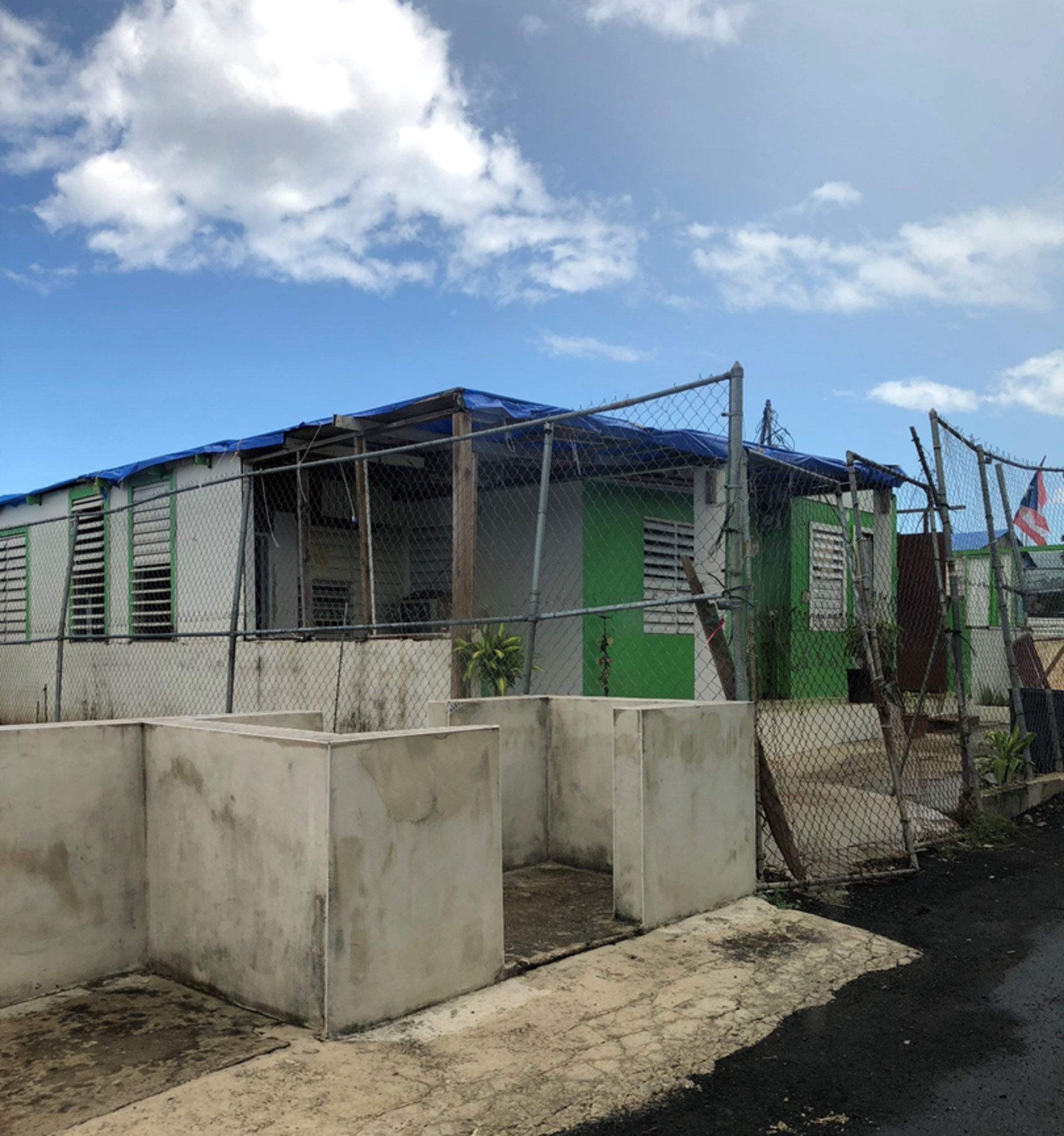
HENRY
by Becky Moon, LKSOM class of 2021
Henry, a pleasant gentleman in his 40s, came to the clinic for his skin rash. He had eczema around his ankles and his skin was severely hardened and dry. As I flipped through his intake form, I was surprised to see he scored the highest possible number for his risk of depression, marking severe for every single question. The nurse I was stationed with carefully walked him through more questions in Spanish to confirm.
“Are you feeling depressed?”
“Yes.”
“Are you having suicidal thoughts?”
“Yes.”
“When was the last time you had suicidal thoughts?”
“Last week.”
“What did you think about?”
“Medicine overdose.”
I was shocked at how calmly he answered all these questions. Like so many first year medical students, I struggled with the part of the patient interview that focused on psychiatric history. We all agree — it’s an uncomfortable thing to ask about. However, Dr. Greenfield, one of the two psychiatrists that joined our trip to Puerto Rico, advised that the best way to ask the patients about their psychological health is simply asking them straightforwardly. Are you depressed? Most of the time, patients have thought about this for a while and can respond without much hesitation. It was clear that Henry has been depressed for a while and has thought about this many, many times.
After prescribing him with some dexamethasone for his eczema, I carefully told him about his depression risk assessment and escorted him to the waiting room to see our psychiatrists. I walked up to Dr. Ortiz and told her about Henry. I suggested we consider taking him before other patients in line because his case seemed urgent. She was willing to see Henry next. As we were going through other patients’ forms, I was overwhelmed to see that the rest of the patients had very high depression risk scores just like Henry. What I thought was urgent was actually very common in this remote part of Puerto Rico, Vieques. It shouldn’t have been a surprise. Their homes were now covered in blue tarp after the roofs had been destroyed from the hurricane. The walls were moldy and wet. Without electricity, they faced complete darkness after the sunset and canned foods were their source of nutrition. Without internet, they were disconnected from the world. Many of their doctors had fled and what was left of hospital staffs operated under tents with temporary power generators. The people felt neglected and isolated. Many were suffering from depression because they had lost so much of what used to make them happy.
Before I came to Puerto Rico for the trip, I was concerned about how much medical impact we could actually make. We had four amazing doctors, brilliant classmates, and bags full of pharmacy drugs. We provided the best medical treatment we could to everyone who walked into our clinic. We gave them the medicines they needed and tried to guide them through their next steps. We even had social workers on site with us. But frankly, with such a short period of time in Puerto Rico, we had to face the limits in continuity of care.
However, during the trip, I realized something else was way more meaningful to the people in Puerto Rico. The fact that we came all the way from Philadelphia to open free clinics accessible to anyone showed them that we cared. The clinic represented more than just medical exams. By listening to all their concerns and holding their hands, we reminded them that they were not being neglected and forgotten.
Henry had come to the clinic with his wife, who had concerns about her high blood pressure. After their doctor visits, as I was walking them out of the clinic, Henry’s wife told me that she was extremely stressed having to take care of her family, including her depressed husband. She was mildly hyperventilating and got teary-eyed as she spoke. I put my hand firmly on her shoulder and told her to take care of her own health first.
“You are most important,” I said. “Take care of yourself.”
She stared at me for a while and started taking deep breaths.
“You are right,” she said. “I need to take care of myself.”
When you are in the midst of a disaster and have other loved ones to take care of, it’s easy to put yourself as the last priority. But everyone’s health is equally valuable and she needed to be reminded of that.
We talked for a few more minutes and she thanked me for coming to Vieques. She gave me a warm hug: “Becky,” she said, “I’ll remember your name. Please come back in the future. I will remember you.” And Henry, right next to her, smiled for the first time.
• • •
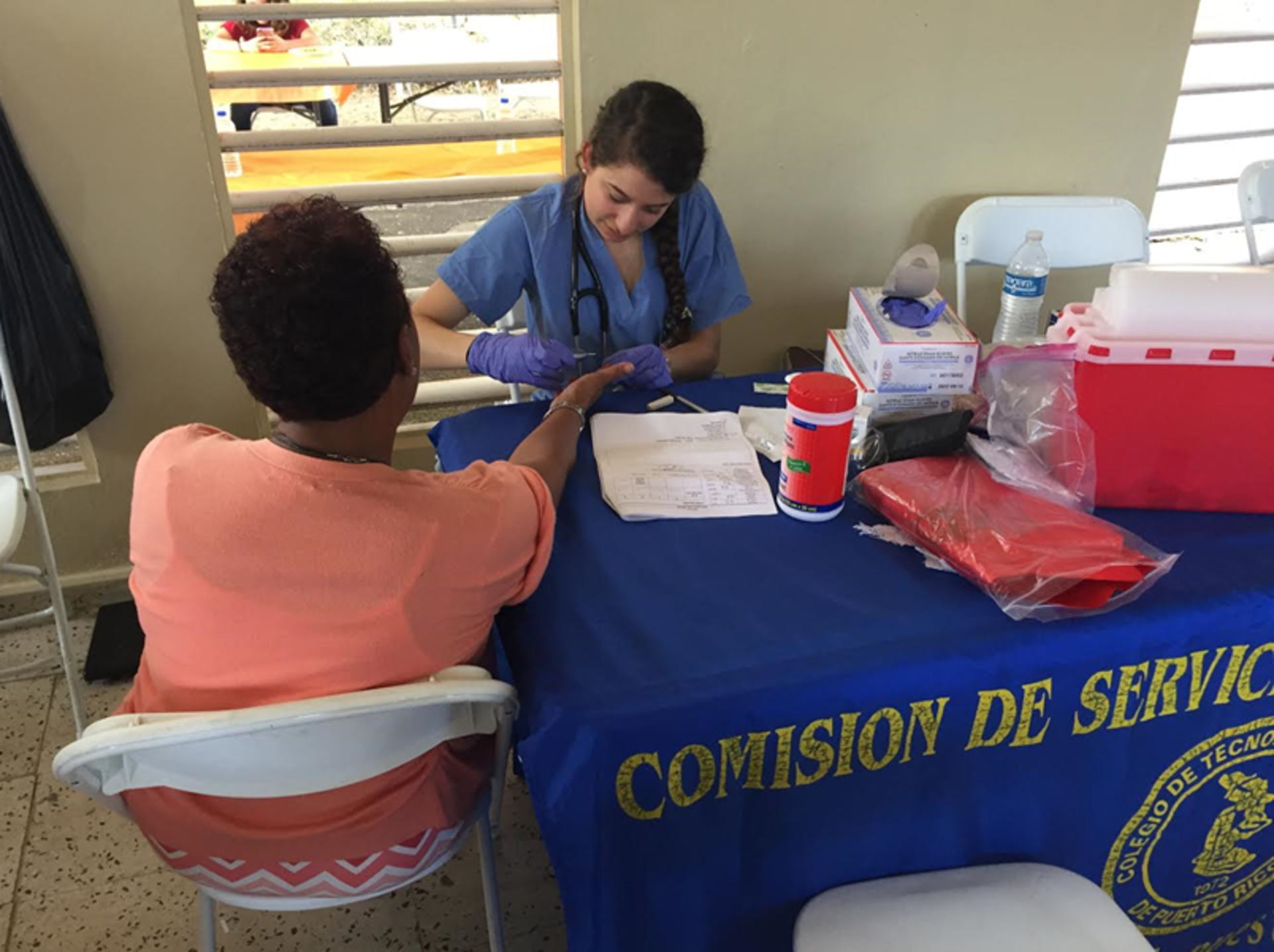
THE GRAND SCHEME
by Maria Saraf, LKSOM class of 2021
After five long days of clinic, we decided to take advantage of the beautiful beaches that Vieques has to offer. Driving on bumpy, unpaved roads and making a few wrong turns, we finally made our way to Pata Prieta, or the Secret Beach. A small trail led to the opening of the beach, and upon reaching it I took a deep breath. Beyond me lay the bluest of blue waters, pure and fresh, surrounded by hot white sand extending into the trees beyond. Huge rocks protected the edges of the beach from the world’s watchful eyes, and for a day, that beauty was only ours to behold. With the sun’s warm rays embracing our skin, we soon found a good spot to claim as ours for the day.
As I sat close to the clear, blue water and gazed at my fellow medical students enjoying it, I pondered on the past five days of clinic. Did we actually do anything here? The cool touch of the water engulfed my feet as a high tide flowed onto the beach and I heard Noha’s voice in the distance. Yes, I think we did. I looked at her, realizing that I had verbalized my thoughts to the sole companion sitting next to me reading a book. She was reading Exit West, a novel by Pakistani author Mohsin Hamid about emigration and trying to find one’s place in the world. Where was our place in all of this? Noha and I talked for a while afterwards about the pitfalls of volunteer tourism and the significance of our work there. I had been struggling trying to place myself in the greater context of what happened in Puerto Rico and I was not sure whether our presence amounted to much. As our conversation progressed, however, my cynical perspective started to shift. Sitting there staring into the endless water while listening to her describe her patient experiences brought a smile to my face.
It was at that moment that I reflected on my last patient encounter the previous day. She was an elderly woman. Slowly walking across the room, she sat facing our psychiatrist, Dr. Greenfield, the translator and me. Once seated, her eyes rose to meet mine, and she held my gaze a few long seconds before doing the same to the others. Since I had witnessed his interaction with the prior patient, Dr. Greenfield allowed me to take the lead with this one.
What brings you here today? I ventured.
I’m depressed, she answered. I waited, unsure of how to proceed.
How long have you felt this way?
Since the hurricane hit.
Can you tell me about that day?
That question opened the door to her unexpected life story, one that she described starting from before, during, and after the hurricane. She talked about her life before the disaster, about her forty plus years in the public sector. She was involved in training government personnel in emergency disaster preparedness, and was proud of her work, retiring only as she approached her mid-70s. She described the day the hurricane hit, one year into her uneventful retirement, destroying her home and leaving her without electricity for close to six months. She detailed her life since, marked with fear whenever the sun disappeared behind clouds or forgetfulness of her actions during those moments. Even now, cloudy weather would instill fear in her heart and disrupt her life. And she was struggling to comprehend how despite being trained in disaster response, her own response was contrary to what she expected. Being a person who enjoys planning and needs to feel prepared, I could relate to her frustrations and confusion in this regard.
The more we talked, the less I relied on the translator. I realized that even though I didn’t understand every word, I could look at her face and know exactly what she was saying. The holes in my Spanish comprehension were filled by reading her body language, by the way she moved her arms to describe how the storm came, by the fear and resilience I could see in her eyes, and by the intonations in her voice. Initially I let the translator’s words guide my understanding and questions, but as her story continued, I learned to adapt that approach. Once I started paying more attention to her, and not just her words, I felt what she meant. I could take part in that conversation emotionally as well. And this time when our eyes met, I held her gaze with a smile on my face and with my hand on hers. What an experience this had been.
Yeah, you’re right, I told Noha. The cool breeze blowing softly across our skin made bearable the heat of the sun. Although the impact we had in Puerto Rico might have been small, the impact Puerto Rico had on us was definitely greater than expected, and I couldn’t be more grateful for it. I looked up at the clear, bright sky and hoped that the elderly woman was enjoying it as much as I was.
• • •
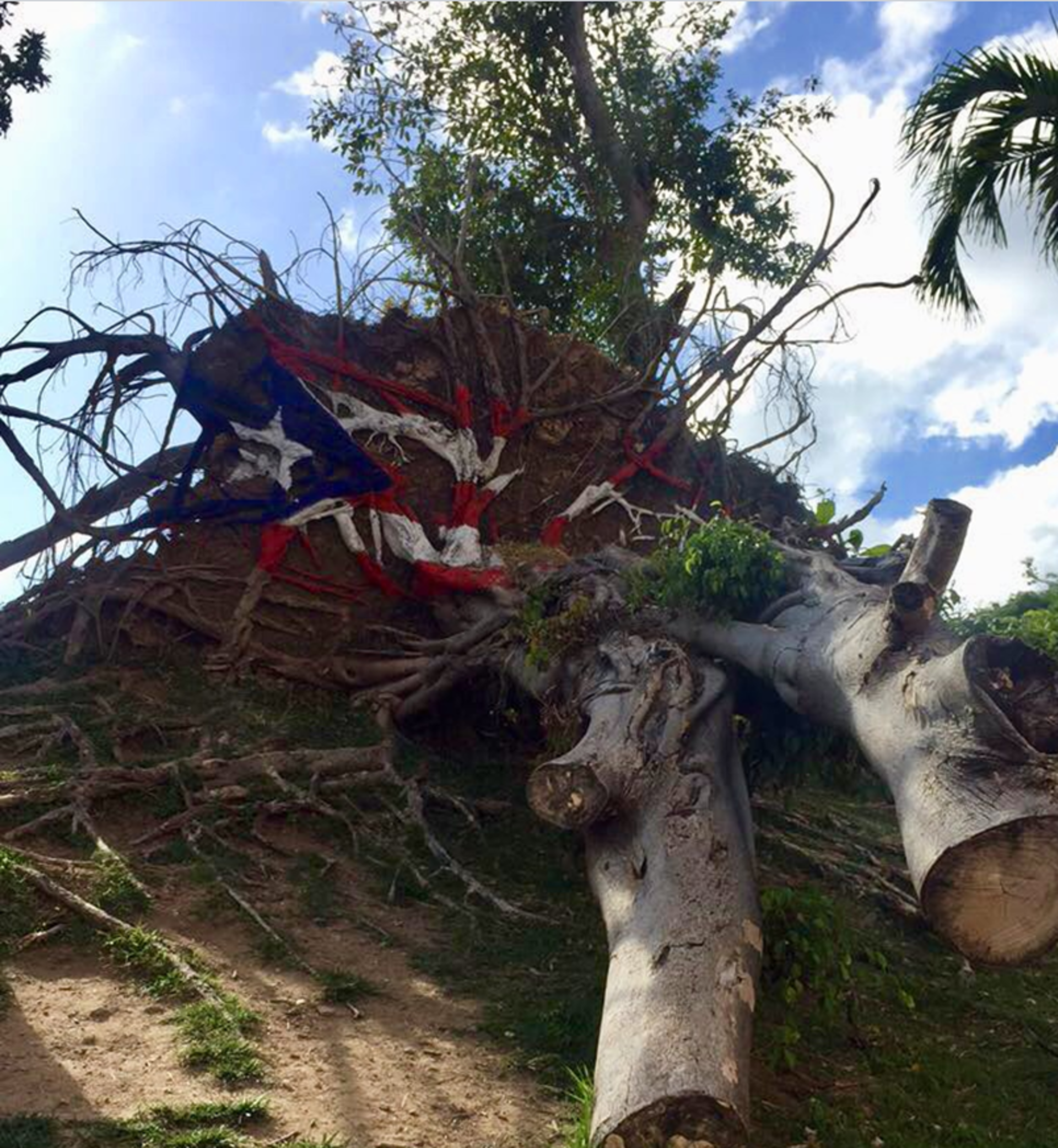
THE ELDERLY PATIENT
by William Schifeling, LKSOM class of 2021
On the second day of clinic in Puerto Rico, I had been stationed to work with Dr. Laura Martin. We saw patients with chronic diseases like hypertension and diabetes to more mysterious problems like rashes reportedly stemming from the hurricane and a lack of menstrual cycle for a relatively young, healthy woman. My job was to bring the patients over, gather their histories, and do a simple physical examination if time permitted. Then I would present the relevant information I had gleaned to Dr. Martin. She would follow up with her own questions and exams and then discuss with patients their illnesses and how to treat them.
Toward the end of the day, we had no more patients to see, but the Temple psychiatrist had become backed up so we decided to take one of his patients. I called the name, and with a large smile an elderly lady got up and followed me back to the general practitioner’s area. As we sat down, I introduced myself and began asking her about why she came to the clinic today. A rather long story unfolded in the next hour with various interruptions. But immediately she treated me with the familiarity of an old friend, tapping my hand or leg to add emphasis to the details of her story. I had the feeling that she was home alone with her husband and was not getting the social interaction she needed. So when we started chatting, she was ready. She was married to her husband for 64 years, a fact she repeated often and of which she was quite proud. But he needed full-time care due to his epilepsy, and she was struggling. Although she had seven accomplished kids scattered over the island and the mainland, she asked them for help only when her husband went to the hospital. It was clear to me that in devoting herself to him, she lacked the means to care for herself.
This is a common story among many Americans, my grandparents included. Although being a doctor will allow me to be a caretaker, it is a certain type of caretaking, one that is guided by science and professionalism, research and education, and one that at times falls short in the most basic ways of caring. Does my grandmother care if her blood pressure rises from 135 to 138 as much as she cares about whether her grandkids remember to call her on her birthday or take her out to her favorite lunch place when they are in town?
When the doctor wrapped up the visit with my elderly patient, she thanked us. Although I did not fully understand what she had said, my doctor translated her words: “Thank you. You took care of me like a son.” I signed up to become a doctor to be a healer. Through listening and caring, I already can be, and I hope I never forget that.
• • •
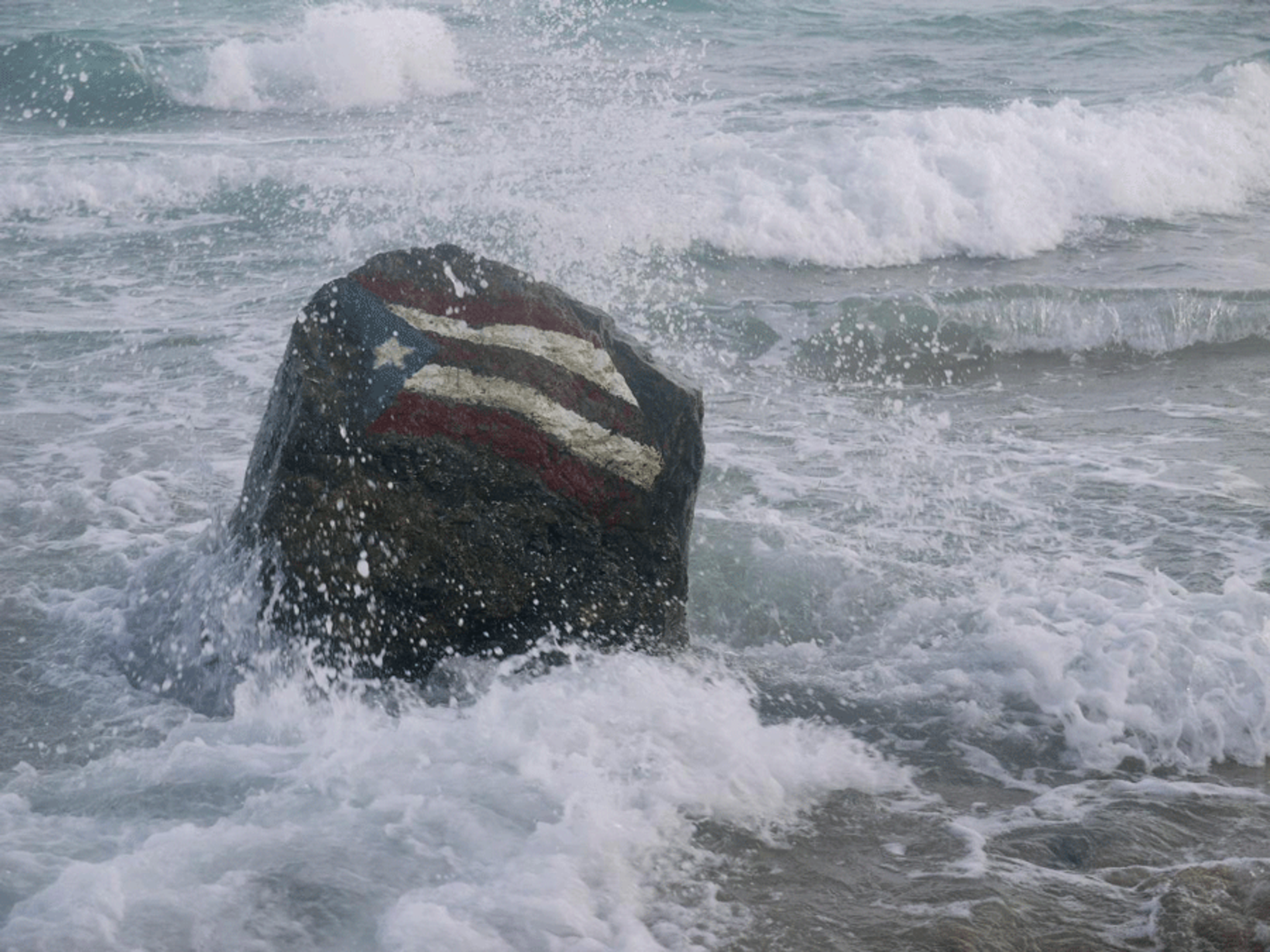
FLAGS
by Joe Corcoran, LKSOM class of 2021
The first flag I saw was torn and ripped.
Its colors pale in the afternoon sun.
Three stripes of red on a white base,
danced and twisted in the wind.
Like maple saplings in a blizzard,
bowing… bending… trying desperately not to break.
The second flag I saw was still and tangled.
Held hostage by a wiry web.
Empty husks that had once lit highways,
and now conducted only empty promises.
The flag’s single star shone bravely,
as if to beckon other stars to follow.
Or maybe just hoping to be seen.
The third flag I saw was painted on a rock,
standing stern in a swollen tide.
Broad strokes on an unkind canvas,
crept back into view with each receding wave.
Claiming victory over an insurmountable foe?
Of just reminding us of its existence,
alone and unsheltered in the frothy sea?
The final flag I saw was drawn on the roots of a tree,
overturned in the winds of the double storms.
Painted beautifully on a hallmark of devastation.
Turning tragedy and sorrow to art and remembrance.
Its single star was made of thick globs of paint,
and spread across the mangle of four root bundles,
leaving space for the evening sun to poke through.
It shone so brightly that for a moment,
it seemed there were fifty other stars shining alongside.
But then a cloud masked the sun,
and the star was all alone.
• • •
Michael Vitez, winner of the 1997 Pulitzer Prize for Explanatory Journalism at The Philadelphia Inquirer, is the director of narrative medicine at the Lewis Katz School of Medicine at Temple University. Michael.vitez@temple.edu
